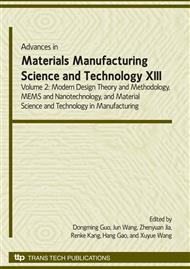p.263
p.269
p.275
p.281
p.287
p.293
p.299
p.305
p.311
Simulation Study of Temperature Field and Stress Field of Disc Brake Based on Direct Coupling Method
Abstract:
In the process of automobile braking, the interaction between the temperature and the dynamic stress of disc brake is a very complex work. In order to simulate this problem accurately, a three-dimensional finite element model was built. Meanwhile the displacement and thermal boundary conditions for solution were determined, in which the coefficient of convection varies with the transient changing of temperature and time. The distributions of stress field and temperature field of the rotor and pads in an emergency braking were analyzed by the direct coupling method. The results of analysis prove that the thermal-structural direct coupling method can simulate the interaction between the stress field and the temperature field more exactly than the axisymmetric method and sequential coupling method do. The changing of stress field is mainly influenced by the temperature field. The results extracted from coupled simulation can give references for the material selection and structural designs in the development of disc brake.
Info:
Periodical:
Pages:
287-292
Citation:
Online since:
August 2009
Authors:
Price:
Сopyright:
© 2009 Trans Tech Publications Ltd. All Rights Reserved
Share:
Citation:


